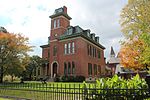Landmark for Peace Memorial
1994 sculpturesAfrican-American history of IndianapolisBronze sculptures in IndianaMemorials to Martin Luther King Jr.Memorials to Robert F. Kennedy ... and 4 more
Monuments and memorials in IndianaOutdoor sculptures in IndianapolisPeace monuments and memorialsSteel sculptures in Indiana
The Landmark for Peace is a memorial sculpture in Dr. Martin Luther King Jr. Park on the northside of Indianapolis. It honors the contributions of the slain leaders Robert F. Kennedy and Martin Luther King Jr. The memorial, which features Kennedy and King reaching out to each other, was designed and executed by Indiana artist Greg Perry. The bronze portraits were created by Indianapolis sculptor Daniel Edwards. On April 4, 2018, the memorial was designated as the Kennedy-King National Commemorative Site.
Excerpt from the Wikipedia article Landmark for Peace Memorial (License: CC BY-SA 3.0, Authors).Landmark for Peace Memorial
Broadway Street, Indianapolis
Geographical coordinates (GPS) Address External links Nearby Places Show on map
Geographical coordinates (GPS)
| Latitude | Longitude |
|---|---|
| N 39.79077 ° | E -86.14637 ° |
Address
Landmark for Peace Memorial
Broadway Street
46202 Indianapolis
Indiana, United States
Open on Google Maps






